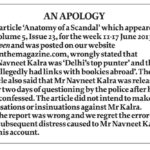The GOD of BIG Things
The evolution of Ganesha from a city deity to one of the most popular gods in the Indian pantheon
 Madhavankutty Pillai
Madhavankutty Pillai
 Madhavankutty Pillai
Madhavankutty Pillai
 |
27 Aug, 2014
|
27 Aug, 2014
/wp-content/uploads/2015/11/God-Ganesha-main.jpg)
The evolution of Ganesha from a city deity to one of the most popular gods in the Indian pantheon
In a city dotted with countless pandals during the ten- day Ganesh Chaturthi festival, Lalbaugcha Raja would be the most popular in Mumbai. Two years ago, the man who wanted to be first to worship the idol came four days beforehand, and behind him, as the festival neared, the queue gradually became longer and longer. There are actually two queues there—one is for people who want to have a look at the deity and pray; the other is for those who have something to request of him. The latter is called the navas line and one has to sometimes stand for more than a day before the turn comes. And what they finally get to see is an idol made by Kambli Arts, run by a family that has been sculpting Lalbaugcha Raja for eight decades.
The workshop of Kambli Arts is in a little lane off the main road in Lalbaug, not very far from where the pandal is. Two weeks before the festival is to begin, idols of Ganesha, big and small, are arrayed inside in different stages of completion. They supply other pandals, but only Lalbaugcha Raja is 14 feet tall, the rest are 9 feet or below. Ratnakar Kambli is the head of the family now. His father, a sculptor of idols, would have roaming exhibitions at festivals across Maharashtra. In 1935, a year after the festival began to be celebrated there, friends recommended his name to the organisers of Lalbaugcha Raja. He passed away in 1952 and his eldest son Venkatesh took over, and after his death, Ratnakar Kambli started designing the idol. The face and body actually changes little but Ganesha’s accouterments—the pose, the throne, the colours, the weapon he holds in his hands—are where the innovations of Kambli Arts come in. Ratnakar’s son, Santosh, who is now the third generation doing this, says that last year they decided to take a risk. Thrones are usually gold, silver or bronze in colour, but they decided to go with purple, the hue of peacock feathers, and in keeping with this motif, instead of lions they had peacocks adorning the base of the seat.
Kambli Arts makes the parts of the Lalbaugcha Raja idol at its workshop and these are then taken to the pandal, assembled and painted. Finally, Ratnakar, who is 73 years old, will go and draw the eyes. He says that the eyes are very important to devotees because that is where they will look and what they should see is Ganesha looking back at them with love. He attributes the phenomenal popularity of Lalbaugcha Raja to how his father conceived this god. He points to a photo of the idol on the wall, and says, “You can see, unlike other images, he is slim and not potbellied. Our Ganapati is a human like figure.” What Kambli’s father did of endowing a god with human likeness is called anthropomorphism, and it holds a clue to the evolution of Ganesha from when he makes his first appearance in history on the back of coins of Indo- Greek rulers.
Among archaeologists and students of ancient Indian culture, Dr MK Dhavalikar is something of a legend. A former archaeology professor who went on to become the director of Pune’s Deccan College Post-Graduate Research Institute, he has authored numerous books on ancient Indian culture, and got a Padma Shri three years ago. Dhavalikar has written a number of papers on Ganesha. He is 84 years old now and it was almost 50 years ago that he first got interested in studying the deity.
In 1962, he was working with the Archeological Survey of India and had been sent to Greece to take part in an excavation for three months. There he encountered figures which combined animals and men (like centaurs) and he wondered whether Ganesha’s form was also in any way connected. Later, while teaching numismatics in India, one of the earliest coins he came across showed Alexander wearing a helmet in the form of an elephant’s head.
He started reading up and in Alexander’s biography found references of a sojourn in Taxila in present day Afghanistan, where, in a shrine at the heart of the city, a sacred elephant was kept and worshipped. Dhavalikar thought that it was possible that the coin represented that elephant. “His governors, the Indo-Greeks, who ruled in the northwestern parts of the Subcontinent, also copied the style,” he says. Dhavalikar also found that when Hiuen Tsang came to India in the 7th century, he came to a city called Kapisa in present day Afghanistan. The city’s presiding deity was in the form of an elephant whose name was Pilusara. (This could be why in Tamil, Ganesha is known as Pilaiyar, because Sanskrit’s ‘sa’ becomes ‘ya’ in the language.) A coin by an Indo-Greek king Eukratides, who ruled that region from 170-150 BCE, shows a coin with an elephant, and, linking it to Hieun Tsang’s account, scholars thought it might represent Pilusara. The elephant deity was associated with a tribe called Hastikas who were predominant there and had the animal as their totem. But it was still not Ganesha as we know him. Rather, at the most, it was a prototype.
Dr Arvind Jamkhedkar, a renowned authority in archaeology, Buddhist studies and art history, says that there are stages in the development of Ganesha as a god and the first phase is the elephant deity of the Subcontinent’s northwest. He says that Ganesha probably started off as a yaksha, one of the semi-divine beings worshipped in primitive Indian societies who often evolve into major gods as they get assimilated into Hinduism. As an indication of Ganesha’s yaksha orgins, he points to the practice of its idols often worshipped with vermillion paste. Originally, yakshas were typically besmeared with blood during worship and the hypothesis is that vermillion came to represent blood later. There is an entire category of such gods who are oblated with vermillion, including Hanuman and Durga, all of whom possibly have yaksha origins.
According to scholars, yakshas have the property of being ambivalent; they are both good and bad. Initially, Ganesha is also like that. In ancient Indian literature, he comes first as Vinayaka, but in the beginning there are more than one entity by that term, with characteristics of yakshas. In an essay Ganesa: The Idea and the Icon, the late AK Narain, a reputed archaeologist and numismatist who did considerable research on Ganesha, says, ‘The name Vinayaka occurs for the first time in the Manava Grihyasutra; it is used there in the plural number to refer to a group of four spirits or lesser gods, namely Salakatankata, Kusmandarajaputra, Usmita and Devayajana, and not for Ganesa.’ In later literature the four (and sometimes five) Vinayakas coalesce into one.
Jamkhedkar says that in keeping with the character of a yaksha, the deity was originally an obstacle creator in such literature. Farmers affected by drought, girls who didn’t find suitable matches or unsuccessful men, would believe that they were suffering from Vinayaka’s curse and the solution was to appease him by making offerings. “The belief was that when these offerings are made, the curse goes away and [the appeaser] becomes successful,” he says. When Ganesha evolves in his individual form, he is first a lord of obstacles—he was worshipped to remove the problems that he himself had created. It is in his final form that he becomes a remover of all obstacles, metamorphosing into a benign lovable god.
Along the way, as his popularity increased, so did myths and legends around him. He is now known as the son of Shiva, but that was not always so. Jamkhedkar cites the example of cave number 21 in Ellora which is dated to 550 CE. “It is a Pashupatha cave and the wedding of Shiva is depicted there. At the head of the procession are Karthikeya and Ganesha,” he says, “What does it mean?” The answer is that the two were not seen as children of Shiva and Parvati, otherwise they couldn’t have been part of the procession. It shows that Ganesha had been brought into the fold of Shiva and Parvati, but it is only later, as his importance grew, that other myths turned him to their son.
During the Tantra period in Indian religious history, when urbanisation grew rapidly and a lot of the autochthonous population came within the fold of Hinduism and their beliefs were assimilated, Ganesha even becomes the supreme deity with the rest of the gods turning subordinate.
But by then, Ganesha was no longer just a Hindu god, even being incorporated into Buddhism and Jainism. In a book Ganesh: Studies of an Asian God, there is an essay by the Jainism scholars Maruti Nandan Tiwari and Kamal Giri titled ‘Images of Ganesa in Jainism’. They write, ‘During the early medieval times ([around the] ninth century AD), the Jainas and the Buddhists also incorporated Ganesa into their pantheon and held him in esteem. This assimilation took place only after the development of a separate Ganpati cult in the early Gupta period ([around the] fifth century AD).’ Tiwari and Giri surveyed the Jain images of Ganesha from that period and concluded that in Jainism, he got a favoured position ‘mainly as a god bestowing success (siddhi). In the beginning he was conceived both as a two-armed and as four-armed, but by the tenth or eleventh century AD he was a prominent Jaina deity and was consequently visualized with six, eight, and even more arms.’
Ganesha also ventures out of India to become a god in southeast Asia. “From the Gupta period, Indians also went to southeast Asia in large numbers,” says Dhavalikar, “They took with them small plaques of Ganesha because he was the obstacle remover. In Indonesia you have such huge images of Ganesha that you don’t have even in India.” Oddly, there are independent temples of Ganesha in southeast Asia, while in India he is mostly a gatekeeper for other divinities, usually kept at the door or entablature.
He was taken to Tibet, China, Japan and Korea along with the spread of Buddhism to those countries. In Japan, he is worshipped even today. “They have their own Japanese names [for Ganesha] but their iconography remains the same. All over Buddhism, Ganesha has gone,” says Jamkhedkar.
What is it that let Ganesha make the leap from his local semi-divine not-so-benevolent origin to a supreme being with the ability to span nations and religions? It has something to do with his fundamental ability of removing obstacles. “That type of god is welcome anywhere,” says Jamkhedkar.
It is also this inherent appeal that made Lokmanya Tilak use the Ganesh Chaturthi festival for political and social mobilisation during the Raj by turning it into a public spectacle. He wanted to make it an instrument of agitation against British rule. Tilak knew that the authorities would have cracked down on political gatherings but wouldn’t touch a religious festival, so it therefore served as a good camouflage.
In the Girgaum area of south Mumbai, the Keshavji Naik Chawl is a long courtyard with residences lined on both sides. Because it housed a number of his associates, this was the first locality to respond to Tilak’s call in Mumbai and hold a public festival in 1893. While the festival’s celebration would go on to change the cultural landscape of Mumbai with phenomenal amounts of money, pomp and power involved, at Keshavji Naik Chawl it continues in the same low-key manner. Instead of racy takes on Bollywood songs as heard at the other pandals, here they stick to traditional Maharashtrian music. “Our children themselves play the drums. It is conducted in a very quiet manner,” says Vinod Satpute, trustee of the mandal. The idol is made of clay and is only 2.25 feet high. And they make it a point to not let politicians take over.
This is not true for the rest of Mumbai, where the festival’s politicisation is complete— every politician worth his salt patronises it. And it is not just in Maharashtra, such public celebrations have been adopted in other states too. Kerala for example never had a tradition of Ganesha immersion, but in 1990, it suddenly began there. The man who initiated it was MS Bhuvanachandran, head of the state’s Shiv Sena unit. “The first few years, it didn’t get much of a following. But now it is a big festival in Thiruvananthapuram,” he says.
And given that everyone likes a god on their side to help them out, another element also came into the picture—criminals. In her sociological treatise on the festival, Performative Politics and the Cultures of Hinduism: Public Uses of Religion in Western India, Raminder Kaur, a professor of Anthropology & Cultural Studies at Sussex University, writes: ‘By the 1980s, there are said to have been forty- five mandal[s] financed by elements of the underworld…Two areas are especially renowned in Mumbai for gangsters collecting donations for the Ganapati utsava— Matunga in central Mumbai, formerly lead by the South Indian smuggler Varadarajan Mudaliar or ‘Vardhabhai’ and Tilaknagar in Chembur in the eastern suburbs led by the don Rajendra Nikhalje alias ‘Chhota Raja’ or Chhotta Rajan.’ YC Pawar, a retired joint commissioner of police, had run-ins with both of them over Ganesh Chaturthi.
In June 1982, when Pawar was first posted as a Deputy Commissioner of Police, Zone 4, Varadarajan Mudaliar’s area of operation, he didn’t know much about the man because he had spent most of his police career outside Mumbai. A few days before Ganesh Chaturthi, he went on a family outing. At a road outside Matunga East, he was stopped by a traffic policeman who said the festival organisers had taken over the area and no vehicles could ply there. Pawar, who did not reveal his identity, asked why there was no public notification about the road being blocked. He was told that it was Varadarajan’s orders. Pawar shouted at the policeman and went ahead. “By that evening a traffic notification was published and the road closed for 10 days for Ganapati. That was the clout of Varadarajan,” he says. “His Ganapati was known to be the best in Mumbai— the most decorated, most expensive and most popular.”
Pawar soon went to war with Varadarajan and over the next few years decimated his empire. In 1986, a strategy he hit upon to ‘cut him down to size’ saw to it that the Ganapati festival Varadarajan organised became rather ordinary. One of the few police inspectors he trusted in the department gave him the idea. “One day he came to me and said ‘Sir, I dont know how far you will agree. [Varadarjan’s] reputation is that he is a godfather and holds this big Ganapati, why not reduce the size of his Ganapati?’ I said, ‘Excellent idea.’” There was a small police chowki outside Matunga railway station. Pawar ordered that it be shifted to the exact place where Varadarajan’s Ganapati would get installed.
He then saw to it that when the application for police permission came, they would not be allowed the use of the entire ground, just a 35 by 35 feet pandal. “We also specified where the pandal should be erected and shifted it to the extreme left southwest corner of that ground,” says Pawar. When the courts were approached against this, the police relented to allow a slightly bigger 45 by 55 feet pandal, but they had hit Varadarajan where it hurt.
In the late 90s, Pawar did the same to the Ganapati that Chhotta Rajan was said to be hosting. Again, an entire ground used to occupied, and Pawar shifted it to a nearby temple. Pawar says there is a reason and process by which criminals come to patronise the festival. “Money is required for celebrations. Where will it come from? Small donations will only bring in a little even if many people give. So extortion becomes a good way to gather funds. That is how goondas join the picture. But unless they are office bearers, why would they collect for a particular Ganapati? They get respectability by associating with the festival. They get money that is extorted. They might get political patronage or become politicians.”
Consider this headline: ‘Ganesh murtis ‘drink’ milk’. And the words below: ‘Murtis of Sri Ganesh “drank” or accepted milk, offered as part of a religious ritual by Hindus yesterday… A steady stream of devotees stood in line yesterday to make offerings to the elephant- headed god, remover of obstacles in the Hindu faith…’
If you took it for a news report of 21 September 1995 when—in what rationalists consider a breakout of religious mass hysteria—idols across India were reported to have started drinking milk, then you were mistaken. It was a 2010 news item that appeared in Trinidad Express, a newspaper in the Caribbean country. Idols of Ganesha drinking milk is a phenomenon which has been reported from many foreign shores that have a large number of people of Indian descent.
Inanimate idols, as science is clear, cannot drink milk—it is just not possible. What is real is that people believe they do and this irrational belief spreads wherever devotees go. We can analyse myths that have come down to us and look for kernels of history in it, but occasionally we also get an insight into how new myths are born. There are many epithets for Ganesha. He is, for example, the God of Beginnings, the Patron of Arts with whose invocation Carnatic music performances begin, he is the Gatekeeper of the Gods, the Endower of Intellect. And since that day in 1995, someone somewhere is also thinking of him as the God that Drinks Milk directly from the devotee’s hands, and his idols are now being fed in faraway Trinidad. A new ritual has been created, another attribute added to his personality, and so the evolution continues.
About The Author
CURRENT ISSUE
Rashmika Mandanna: India’s Sweetheart
MOst Popular
3

/wp-content/uploads/2025/04/Cover-Rashmika-New.jpg)











More Columns
CPM alarmed by shrinking student base Ullekh NP
With No Big Win, BCCI Says No To Hike In Annual Retainership For Women Short Post
The Legacy of Manoj Kumar Madhavankutty Pillai